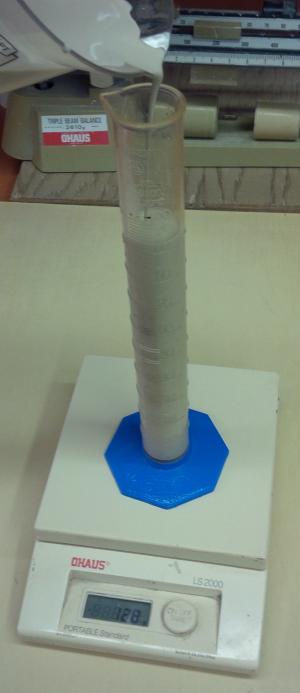| Monthly Tech-Tip | No tracking! No ads! | |
More problems measuring glaze specific gravity using a hydrometer
Potters sometimes call this a "floating thingy". Maybe, because of the problems it presents, it does not make a big enough impression to remember the name! Because of the length of the hydrometer the only container we have is this graduated cylinder. I have to fill it just the right level so it reads near the top. OK, fine. But the hydrometer needs to bob up and down to find home. However, this glaze has our desired thixotropy, which prevents free movement. OK, I will carefully help it find home by pushing it down a little. But then it doesn’t want to bob back up! Ok, I’ll pull it up ... then is doesn't want to go back down to where it should float. Not great. Next problem: The glaze is opaque, I can’t see the reading. Yikes! A better way would be to throw out the hydrometer and just tare the empty cylinder on a scale, fill it to 100 and read the SG as the weight/100. Or fill it to any mark and divide the weight by that.
Related Pictures
Carefully measure specific gravity using a scale and graduated cylinder

This picture has its own page with more detail, click here to see it.
This is a convenient way to measure the specific gravity of a glaze or clay slurry fairly accurately. Get a graduated cylinder like this (e.g. Amazon.com). Be careful with cheap plastic ones, check them with water and mark the true 100cc mark if needed. Counterbalance the empty graduated cylinder to zero on your 0.01g scale. Fill it to the 100 mark. The specific gravity is the weight divided by 100.
When to use a hydrometer and when not to

This picture has its own page with more detail, click here to see it.
If a glaze has already been mixed and gelled to give it thixotropy these things won't bob up and down to home in on the right level. If the glaze is watery enough there are other issues. The one on the right has a 1.0-1.7 scale. Since most pottery glazes need to be 1.4-1.5 specific gravity (40-50 on this scale) it is difficult to get a very accurate reading. And it is long, you will need a container tall enough to float it and enough glaze to fill it. The small hydrometer appears better, it has a scale of 1.2 to 1.45. But it really bobs up and down (so it is even more important that the slurry be runny and thin to give it the freedom to do so). But glaze slurries are creamy. So it is better to weigh a measured volume of glaze slurry and calculate the SG instead. The easiest is a 100cc graduated cylinder (from Amazon.com), if 100 ccs weighs 140 grams, that is 1.4 specific gravity. You don't even have to pour in 100cc, just pour in any amount and divide the weight by the amount.
Videos
Links
| Glossary |
Specific gravity
In ceramics, the specific gravity of slurries tells us their water-to-solids ratio. That ratio is a key indicator of performance and enabler of consistency. |
| Glossary |
Thixotropy
Thixotropy is a property of ceramic slurries of high water content. Thixotropic suspensions flow when moving but gel after sitting (for a few moments more depending on application). This phenomenon is helpful in getting even, drip-free glaze coverage. |
| Glossary |
Slip Casting
A method of forming ceramics. A deflocculated (low water content) slurry is poured into absorbent plaster molds. As it sits in the mold, usually 10+ minutes, a layer builds against the mold walls. When thick enough the mold is drained. |
Got a Question?
Buy me a coffee and we can talk

https://digitalfire.com, All Rights Reserved
Privacy Policy

